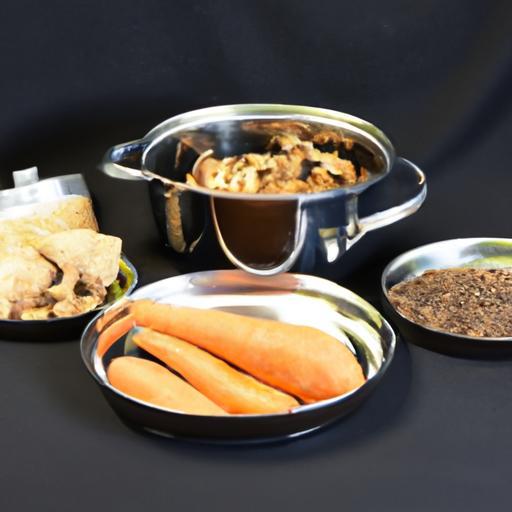In a world that spins with unpredictability-from sudden storms to unexpected disruptions-being prepared isn’t just smart; it’s essential. Imagine having a pantry that’s more than just a collection of snacks, but a fortress of nourishment ready to keep you and your loved ones thriving when times get tough. Welcome to the ultimate guide on emergency food storage: “Keep Calm & Stock Up.” Here, we’ll journey through the art and science of building a resilient food supply, blending practical tips with savvy strategies to help you face the unforeseen with confidence. Whether you’re a seasoned prepper or a curious beginner, this guide is your roadmap to peace of mind, one carefully chosen can at a time.
Keep Calm & Stock Up: Ultimate Emergency Food Storage Guide
Keep Calm & Stock Up with the ultimate emergency food storage guide to ensure your pantry is prepared for any long-term survival scenario. Selecting the right foods, maximizing their shelf life, and organizing your stockpile efficiently are essential steps that empower you to provide nutritious, comforting meals when traditional grocery runs aren’t an option. Drawing from years of culinary expertise and food styling finesse, this guide transforms the intimidating task of stocking emergency foods into a manageable and inspiring culinary journey.
Prep and Cook Time
Time Required: 30 minutes preparation + ongoing storage maintenance
Yield
Enough provisions to sustain a household of 4 for 2 weeks or longer depending on rationing and selected foods.
Difficulty Level
Medium – Requires planning, sourcing proper containers, and understanding food properties for longevity.
Ingredients for Building Your Emergency Food Stockpile
- Whole grains: 10 lbs brown rice, 5 lbs quinoa, 5 lbs rolled oats
- Dried legumes: 5 lbs lentils, 5 lbs chickpeas, 5 lbs black beans
- Canned proteins: 12 cans of salmon, 12 cans of chicken, 8 cans of beans (low sodium)
- Freeze-dried vegetables: 4 lbs mixed vegetables (carrots, peas, corn)
- Dehydrated fruits: 3 lbs raisins, 2 lbs dried apricots
- Fats and oils: 1 liter olive oil, 1 lb powdered butter
- Essential spices: 2 oz sea salt, 2 oz black pepper, 2 oz garlic powder, 2 oz dried herbs
- Powdered dairy: 3 lbs powdered milk, 2 lbs powdered cheese
- Honey and sweeteners: 1 quart raw honey, 2 lbs brown sugar
- Water purification tablets: 1 pack for safe hydration
Step-by-Step Instructions on Maximizing Shelf Life and Storage
- Choose cool, dry, and dark storage locations – Basements or pantries away from sunlight reduce temperature fluctuations that degrade food quality.
- Use airtight containers – Transfer bulk grains and legumes into Mylar bags with oxygen absorbers, then place them inside BPA-free, airtight plastic bins or glass jars.
- Label everything – Clearly write purchase and expiration dates on all containers to maintain stock rotation easily.
- Vacuum seal perishables – Freeze-dried and dehydrated packages should be vacuum sealed to prevent moisture and oxidation deterioration.
- Organize by category and expiry date – Arrange canned goods, dry foods, and packaged items separately; position items expiring soonest at the front.
- Regularly inspect your stockpile – Every 3 months, check for swelling cans, moisture, or pest intrusions.
- Tailor portions and ingredients – Adjust quantities for family dietary needs: vegetarian, allergy considerations, or calorie requirements to avoid waste.
- Implement a first-in, first-out (FIFO) system – Prevents unnecessary spoilage and keeps the emergency pantry fresh and usable.
Chef’s Notes and Tips for Success
- Rotate your stockpile seasonally to maintain freshness and diversify nutrition with available local produce options.
- Consider allergen-free alternatives (e.g., gluten-free grains like quinoa) to accommodate all family members.
- Freeze leftover herbs and spices into ice cube trays with olive oil for quick flavor additions in survival cooking.
- Use stackable, clear containers to visually monitor supplies without disturbing the entire pantry.
- Incorporate a variety of protein sources to maintain muscle health and satisfaction in long-term diets.
Serving Suggestions for Emergency Preparedness Cooking
Transform simple stored foods into wholesome meals by combining canned proteins and freeze-dried vegetables into hearty stews or grain bowls. Garnish dishes with rehydrated herbs or dried spice blends to elevate flavor and morale. Encourage creativity; a little olive oil drizzle or honey can enrich otherwise plain sustenance into a culinary experience that nourishes both body and spirit during uncertain times.
| Ingredient | Calories (per 100g) | Protein (g) | Carbohydrates (g) | Fat (g) |
|---|---|---|---|---|
| Brown Rice (cooked) | 112 | 2.6 | 23 | 0.9 |
| Lentils (dry) | 353 | 26 | 60 | 1.1 |
| Canned Salmon | 142 | 20 | 0 | 6 |
| Freeze-Dried Mixed Vegetables | 350 | 12 | 65 | 1.5 |
Explore more survival pantry essentials and ensure your preparedness is thorough. For expert food safety guidance, visit the USDA Food Safety and Inspection Service.

Q&A
Q&A: Keep Calm & Stock Up: Ultimate Emergency Food Storage Guide
Q1: Why is it important to keep calm and stock up on emergency food?
A: Because disasters don’t schedule appointments! Staying calm helps you think clearly, while stocking up ensures you’re prepared for unexpected events-power outages, natural disasters, or even just that surprise weekend getaway gone awry. Having food on hand means peace of mind and the ability to focus on what truly matters: safety and well-being.
Q2: What types of foods are best for emergency storage?
A: Think long-lasting, nutrient-packed, and easy-to-prepare. Canned goods, dried legumes, rice, pasta, freeze-dried meals, and nuts are heroes here. Don’t forget comfort foods like chocolate or hard candy-they keep morale high when things get tough!
Q3: How long should my emergency food supply last?
A: Aim for a minimum of three days per person-many experts suggest two weeks for added security. It’s a balance between storage space and preparedness. The longer you can stockpile, the better you’ll weather extended emergencies.
Q4: How do I store emergency food properly?
A: Cool, dark, dry places are your best friends. Think basements, pantries, or even closets away from heat and moisture. Use airtight containers to protect from pests and spoilage. Rotate your stock every six months to a year so nothing goes to waste.
Q5: Can I store fresh produce for emergencies?
A: Fresh fruits and veggies have a limited shelf life, but root vegetables (like potatoes, carrots, and onions) store relatively well. For longer-lasting nutrition, focus on frozen, canned, or dehydrated options, which keep their vitamins and flavors intact much longer.
Q6: How do I make emergency meals with my stored food?
A: Keep it simple! Boil water for rice or pasta, open cans for salads or chili, and rehydrate dried meals with hot water. Plan in advance by trying out recipes today to know what your family likes and what is easiest to prepare.
Q7: Are there any special considerations for families with kids or pets?
A: Absolutely! Kids and pets have unique dietary needs. Stock age-appropriate baby foods, formula, or snacks, plus pet food and treats. Keep extra water for animals and consider their comfort alongside your own.
Q8: How often should I review and update my emergency food supplies?
A: Set a twice-yearly reminder to check expiration dates, replace used items, and adjust quantities for any household changes. This routine keeps your stash fresh and ready to roll whenever life throws a curveball.
Q9: What’s a quick tip to stay motivated in building my emergency food supply?
A: Treat it like a fun challenge or treasure hunt! Add one or two items each shopping trip, and imagine the self-sufficiency and security you’re creating. Plus, you’ll get creative with meal ideas along the way.
Q10: Can emergency food storage save money in the long run?
A: You bet! Buying in bulk and on sale reduces grocery bills, and having staples on hand prevents last-minute expensive purchases during emergencies. Plus, less food waste when you rotate thoughtfully.
Keep calm, stock up, and savor the confidence that comes with being prepared-your future self will thank you!
In Retrospect
As you close this guide, remember: preparedness isn’t about fear-it’s about peace of mind. By thoughtfully stocking up and planning ahead, you invest in a safety net that nourishes not only your body but your confidence in uncertain times. So keep calm, stay informed, and let your pantry be a quiet champion in every emergency. Because when the unexpected strikes, the best recipe is resilience-one well-stocked shelf at a time.








